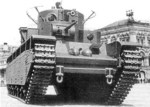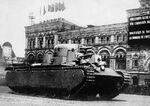T-35
| Country | Russia |
| Manufacturer | Malyshev Factory, Kharkov, Ukraine |
| Primary Role | Heavy Tank |
Contributor: C. Peter Chen
ww2dbaseDesigned by the team led by N. Tsiest at the Soviet OKMO design bureau in the early 1930s, what would eventually be designated the T-35 heavy tanks were meant to serve in the role of creating gaps in enemy defensive lines for the infantry to pour through. The design might have had British influence, specifically the A1E1 Independent design by Vickers. The first prototype was completed in Jul 1932; considered too complex, the design was reworked, and on 11 Aug 1933 the design was accepted for production. T-35 heavy tanks each had five turrets, with the main turrets housing 76.2-millimeter guns and the secondary turrets housing 45-millimeter guns or machine guns. They were the only production heavy tanks in the world with five turrets each. Between 1933 and 1935, twenty units were built. The experiences gained from the initial production run resulted in the T-35 Model 1935 variant design, which had longer chassis and larger 45-millimeter guns; about 35 T-35 Model 1935 tanks were built between 1935 and 1938. A small number of other variants were also built in the 1930s, including some with sloped-armored turrets and some with improved side skirts. Production ended in 1938 due to its high cost. A total of 61 vehicles were built.
ww2dbaseAt the start of the European War in Sep 1939, T-35 heavy tanks served with the Soviet 5th Separate Heavy Tank Brigade based in Moscow, Russia; they served mainly ceremonial functions, participating in parades and other non-combat situations. In Jun 1940, it was decided that even though they were showing signs of obsolescence, they would continue to serve in active duty. Later that year, they were transferred to the Soviet 34th Tank Division, equipping 67th and 68th Tank Regiments based in Kiev, Ukraine. When Germany invaded the Soviet Union in Jun 1941, they were engaged in combat for the first time. Many of them were lost in action, not due to enemy fire however, rather due to mechanical failures or scuttling. All T-35 tanks that survived Operation Barbarossa were transferred to Moscow where they participated in the defense of the capital city. All T-35 heavy tanks that survived the Battle of Moscow remained in the rear for the remainder of the European War.
ww2dbaseSource: Wikipedia.
Last Major Revision: Nov 2010
T-35 Timeline
| 11 Aug 1933 | The Soviet Army accepted the five-turreted T-35 heavy tank design for production. |
SPECIFICATIONS
T-35
| Machinery | One Mikulin M-17M 12-cylinder gasoline engine rated at 500hp |
| Suspension | Coil Spring |
| Armament | 1x76.2mm Model 27/32 gun, 2x45mm guns, up to 6x7.62mm machine guns |
| Armor | 11-30mm |
| Crew | 11 |
| Length | 9.72 m |
| Width | 3.20 m |
| Height | 3.43 m |
| Weight | 45.0 t |
| Speed | 30 km/h |
| Range | 150 km |
Photographs
 |  |  |  |
Did you enjoy this article or find this article helpful? If so, please consider supporting us on Patreon. Even $1 per month will go a long way! Thank you. Share this article with your friends: Stay updated with WW2DB: |
Visitor Submitted Comments
15 Apr 2011 08:17:57 PM
During the German invasion of the Soviet Union, June 22, 1941, 90% of the T-35s were
lost, not to enemy action but due to mechanical failure.
The last action of the T-35 took place during
the Battle of Moscow, the survivors were later used for training. One T-35 is on display at the Kubinka Tank Museum Moscow, Russia.
15 Apr 2011 08:18:28 PM
During the German invasion of the Soviet Union, June 22, 1941, 90% of the T-35s were
lost, not to enemy action but due to mechanical failure.
The last action of the T-35 took place during
the Battle of Moscow, the survivors were later used for training. One T-35 is on display at the Kubinka Tank Museum Moscow, Russia.
10 May 2011 02:25:35 PM
they look like the can destroy anything that got inthe way O.O
All visitor submitted comments are opinions of those making the submissions and do not reflect views of WW2DB.
- » WW2DB's 19th Anniversary (29 Dec 2023)
- » Looted Painting "Madonna with Child" Returned to Poland (2 Jun 2023)
- » Wreck of USS Mannert L. Abele Found (29 May 2023)
- » Wreck of Montevideo Maru Found (25 Apr 2023)
- » Accidental Detonation of a WW2-Era Bomb in Great Yarmouth (10 Feb 2023)
- » See all news
- » 1,146 biographies
- » 336 events
- » 43,422 timeline entries
- » 1,237 ships
- » 349 aircraft models
- » 207 vehicle models
- » 372 weapon models
- » 123 historical documents
- » 259 facilities
- » 468 book reviews
- » 28,395 photos
- » 432 maps
Thomas Dodd, late 1945
Please consider supporting us on Patreon. Even $1 a month will go a long way. Thank you!
Or, please support us by purchasing some WW2DB merchandise at TeeSpring, Thank you!
17 Nov 2010 12:06:49 PM
The T-35 Model 1932 was the first in a family
of "Land Battleships" it was a monster, with
multi-turret design.
It was armed with a 76mm (3in) Howitzer in
the main turret, flanked by four sub-turrets two with 45mm guns, and the other with
7.62mm machine guns. This machine had a crew
of eleven!
The tank, was powered by a 12 cylinder gas
engine of 500hp with a range of 150km/93miles